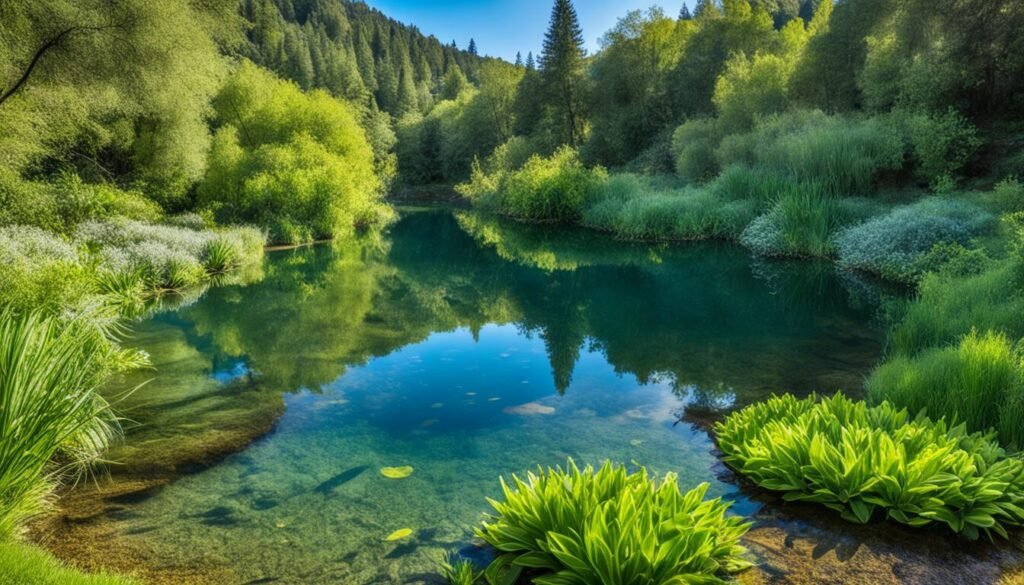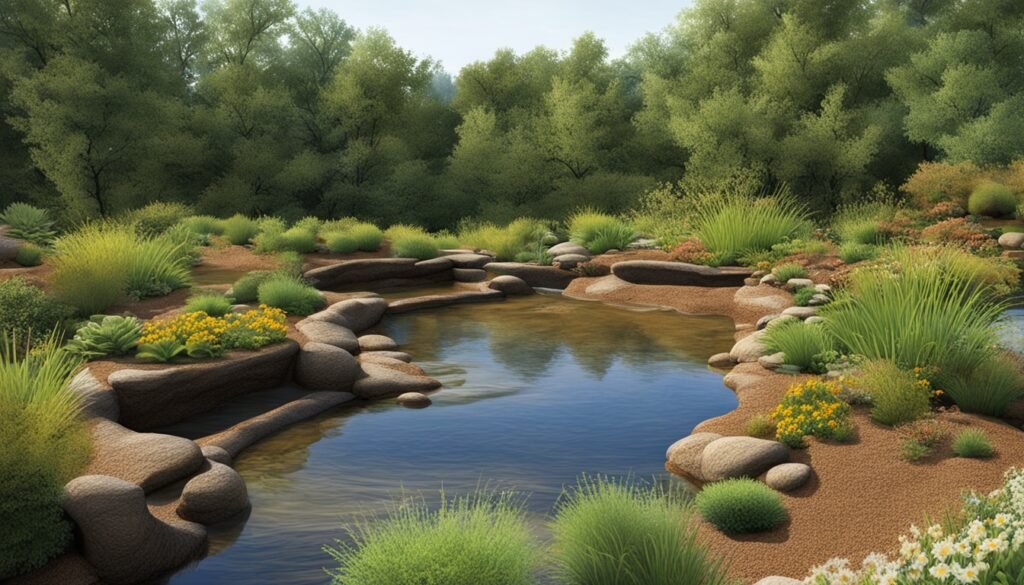I recall the first time I encountered a hidden pond during a hike. The serene water, teeming with life, captivated me.
It sparked my curiosity about the pond formation process and prompted me to answer this one question – how did this oasis come to be?

Ponds are nature’s little miracles. Simply, they form when water collects in dips in the land. Some are born from melting glaciers, while others spring up after volcanic activity. Natural pond creation is a fascinating process that shapes our landscape.
Of course, water sources for ponds vary. Rain, underground springs, and small streams all play a part, and, over time, these bodies of water change. They gather nutrients and plant matter, creating rich ecosystems. So let’s now, quite literally, dive into the fascinating world of ponds and uncover the secrets of their birth and growth.
Understanding Pond Basics
Defining a Pond: Size and Characteristics
Ponds, by definition, are smaller and shallower than lakes, allowing sunlight to penetrate to the bottom. This supports plant growth throughout. They are characterized by their ability to host diverse life forms.
Types of Ponds: Natural vs. Man-made
Ponds can either form naturally or be created by humans. Natural ponds arise from geological processes, while man-made ponds have various purposes like agriculture or recreation. Both types are essential for pond biodiversity.
The Importance of Ponds in Ecosystems
Ponds are crucial to our environment. They support a broad range of plants and animals, enhancing local biodiversity. The pond ecology is intricate, with each organism playing a distinct role. From algae to insects to amphibians, ponds are alive with diversity.
| Pond Type | Key Characteristics | Ecological Importance |
|---|---|---|
| Oligotrophic | Low nutrient content, clear water | Supports specialized species |
| Eutrophic | High nutrient content, abundant plant life | High biodiversity, important for nutrient cycling |
| Temporary | Seasonal water presence | Crucial for certain amphibian species |
Understanding pond basics reveals their significance in our ecosystems. Whether natural or man-made, ponds are essential for ecological balance and support diverse life forms.
How Does a Pond Form?
Ponds are captivating water bodies that emerge from a blend of geological processes, glacial activity, and water accumulation. These elements intertwine to shape the landscape, creating depressions that eventually fill with water. Let’s delve into the specifics of how these processes contribute to pond formation.
Natural Depressions and Geological Processes
Geological processes are pivotal in sculpting natural depressions, which can evolve into ponds. These depressions act as reservoirs, collecting water from the soil and underlying materials. Over time, erosion and weathering refine the landscape, crafting hollows where water can settle.

Glacial Activity and Pond Formation
Glacial activity significantly influences pond creation. Glaciers, as they traverse the terrain, carve out depressions and leave behind residual hollows upon melting. These glacial remnants frequently become ponds, mirroring the intricate mating and reproduction patterns of species like goldfish, where precise environmental conditions are crucial for success.
The Role of Precipitation and Runoff
Precipitation and runoff are vital for pond formation. In regions with abundant rainfall or snowmelt, water converges in natural depressions. This accumulation is particularly significant for seasonal ponds, such as vernal pools, which emerge during wet seasons.
| Pond Formation Factor | Description | Impact |
|---|---|---|
| Geological Processes | Erosion and weathering | Creates natural depressions |
| Glacial Activity | Ice movement and melting | Carves out hollows |
| Precipitation | Rainfall and snowmelt | Fills depressions with water |
Natural Pond Formation Processes
I’m always captivated by the intricate processes behind natural pond creation. These water bodies form through a complex interplay of geological, hydrological, and biological factors. Let’s explore how nature crafts these aquatic marvels.
The process starts with depressions in the ground filling with water. This water collection can stem from rainfall, melting snow, or underground springs. As time elapses, pioneer plants and emergent vegetation emerge, signaling the beginning of ecosystem development.
The cycle of plant growth, death, and decomposition is pivotal. It gradually builds up soil layers, reshaping the pond’s structure over time. This process, known as ecological succession, can extend over hundreds of years. Ponds may transition into marshes, swamps, and eventually dry land during this period.
| Stage | Characteristics | Dominant Life Forms |
|---|---|---|
| Early Pond | Open water, few plants | Algae, aquatic insects |
| Mature Pond | Emergent vegetation, diverse life | Fish, amphibians, aquatic plants |
| Marsh | Shallow water, dense vegetation | Reeds, waterfowl, small mammals |
| Swamp | Tree-dominated wetland | Trees, shrubs, diverse wildlife |
Grasping these natural processes is essential for appreciating the dynamic nature of ponds. It also aids in managing and maintaining these crucial ecosystems. Observing ponds in various developmental stages, I’m constantly reminded of nature’s incredible ability to create and transform landscapes.
Human Influences on Pond Creation
I’ve witnessed the profound impact of human ingenuity on the landscape through the creation of man-made ponds. These artificial water bodies cater to diverse purposes, significantly influencing our environment.
Artificial Construction Methods
Excavation stands out as a favored approach in pond construction. I’ve observed teams meticulously dig out vast areas, subsequently lining them with materials like clay or plastic to ensure water retention. Occasionally, small streams are dammed, creating ponds with a tailored size and shape.
Agricultural and Land Development Impacts
Land development often necessitates the creation of ponds. I’ve noted how new residential projects incorporate these water features for stormwater management, preventing flooding. In the agricultural sector, ponds are vital for irrigation, offering a consistent water supply for crops.
Pond Creation for Conservation Purposes
Conservation initiatives frequently involve the construction of ponds. I’ve visited sites where ponds were established to revitalize habitats and support local wildlife. These endeavors enhance biodiversity by creating controlled aquatic environments. It’s fascinating to observe how swiftly these ecosystems flourish, drawing in a variety of plant and animal species.
Human-made ponds engage with natural processes, evolving into distinct ecosystems. Initially artificial, they gradually become essential components of the landscape. Over time, they blend seamlessly with their surroundings, fostering diverse life forms.
Pond Ecology and Ecosystem Dynamics
Ponds are vibrant ecosystems, filled with diverse life forms and plants. Exploring pond ecology reveals the complex relationships among species. These ecosystems, though small, have their own balance and dynamics.
Aquatic Life in Ponds
From microorganisms to frogs, ponds are home to a wide variety of creatures. Fish and dragonflies move through underwater and surface vegetation. The health of these species reflects the pond’s water quality. Regular maintenance is crucial for maintaining these ecosystems.
Vegetation and Plant Life
Plants are vital to pond ecosystems. They produce oxygen, provide food, and shelter for aquatic life. Floating plants like duckweed can quickly cover the pond’s surface. Underwater plants are equally important, maintaining the pond’s ecological balance.
Water Characteristics and Environmental Factors
The physical and chemical properties of pond water affect its inhabitants. Temperature, depth, and pH levels shape the ecosystem. Seasonal changes impact water quality and the life cycles of pond species. Understanding these factors is essential for effective pond management and preserving aquatic ecosystems.
FAQ
What is the definition of a pond?
A pond is a small, freshwater body, typically smaller than a lake, with shallow waters that let sunlight reach the bottom. This supports plant life. Ponds can be either natural or created by humans, and they can be temporary or last forever. They vary in their health, from very clean to highly polluted.
How do natural ponds form?
Natural ponds form through various geological events. For instance, depressions in the earth can collect water from the soil and underground layers. Glaciers can also carve out valleys, creating ponds. Rainwater and runoff can fill shallow depressions, forming temporary ponds known as vernal ponds.
What is the process of natural pond formation over time?
The formation of natural ponds is a complex process. It begins with depressions in the ground filling with water from different sources. Then, pioneer plants start to grow, followed by other types of vegetation. This cycle of growth, death, and decomposition builds up the soil over time.
Eventually, this process can transform ponds into marshes, swamps, and even dry land. This change happens over hundreds of years through a process called ecological succession.
How do humans influence pond creation?
Humans play a big role in creating ponds. We do this through excavation and damming small rivers or streams. We also create ponds during land development projects to manage stormwater or to restore habitats and support biodiversity.
What are the key components of a pond ecosystem?
Pond ecosystems are complex and support a wide range of life, from fish and amphibians to insects and microorganisms. Plants are crucial, providing oxygen, shelter, and food. The health of a pond depends on factors like water temperature, depth, pH levels, and nutrient content.
Environmental factors such as seasonal changes and climate also play a big role in shaping the pond’s ecosystem.

